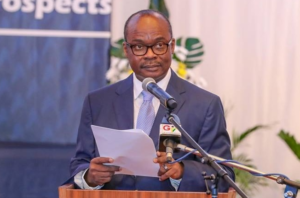
Accra, Ghana, November 25, 2019//-The Monetary Policy Committee (MPC) of the Bank of Ghana (BoG) has maintained its policy rate 16% for five consecutive times.
The Chairman of the MPC and Governor of BoG, Dr Ernest Addison made the announcement at a press briefing in Accra today, explained: “The latest forecast shows that inflation will remain within the target band over the forecast horizon, barring any unforeseen shocks”.
Inflation expectations, derived from the surveys, remain fairly anchored in single digits and core inflation (excluding energy and utilities) is expected to remain at low levels”.
In view of the committee’s assessment, risks to the inflation outlook were broadly balanced, therefore the Committee decided to maintain the policy rate at 16 percent while monitoring developments going forward, Dr Addison told journalists in Accra.
The policy rate is the rate at which the central bank lends to the commercial banks in the country. Keeping the rate at 16% implies that all the commercial banks are expected to keep their interest rates in the country.
He continued: “The three readings of inflation since the release of the rebased Consumer Price Index by the Ghana Statistical Service show that inflation has remained below its central path of 8 percent”.
Headline inflation declined from 7.8 percent in August 2019 to 7.6 percent in September, and has since inched up to 7.7 percent in October on the back of the recent upward adjustment in administrative prices of electricity and water.
“Looking ahead, inflation is projected to stay within the medium-term target of 8±2 percent over the forecast horizon. Inflation expectations for businesses, consumers, and the financial sector, appear to be well-anchored within single digits despite a slight pick-up in the Bank’s measure of core inflation (headline inflation excluding fuel and utilities)”.
Also, the foreign exchange market has continued to remain calm since the sharp depreciations in the first quarter of the year. As at November 21, 2019, the Ghana cedi has depreciated by 10.4 percent against the US dollar compared with an 8.1 percent depreciation for the corresponding period in 2018.
Against the British pound and euro, the Ghana cedi cumulatively depreciated by 11.2 percent and 7.4 percent respectively, compared with 2.6 percent and 2.8 percent over the corresponding period in 2018. In trade-weighted terms, the real effective exchange rate continued to be broadly aligned with the underlying fundamentals, according to Dr Addison.
Whereas developments in monetary aggregates are consistent with the trends in aggregate demand, he said.
Growth in broad money (M2+) remained strong during the year. In year-on-year terms, growth in M2+ was 16.3 percent in October 2019. Reserve money also expanded in the review period. Growth in reserve money went up by 26.1 percent, compared with 4.3 percent over the same comparative period.
Touching on the health of the Ghanaian economy, Dr Addison noted that growth momentum continues to remain strong and has been sustained since last year.
The Bank’s updated Composite Index of Economic Activity (CIEA) continues to show a steady pick-up in economic activity.
The CIEA recorded an annual growth of 4.4 percent in September 2019, compared with 5.8 percent in the corresponding period of 2018. The key drivers of economic activity during the period were port activity, domestic consumption, tourist arrivals and DMB’s credit to the private sector.
Results from the Bank of Ghana’s latest confidence surveys, conducted in October 2019, pointed to improved business sentiments. Business confidence has rebounded, due mainly to favourable company and industry prospects, positive growth outlook and declining lending rates. Consumer sentiments, on the other hand, remained broadly unchanged from the previous survey.
African Eye Report


